PLANETARY CANDIDATES OBSERVED BY Kepler. VIII. A FULLY AUTOMATED CATALOG WITH MEASURED COMPLETENESS AND RELIABILITY BASED ON DATA RELEASE 25
- PMID: 32908325
- PMCID: PMC7477822
- DOI: 10.3847/1538-4365/aab4f9
PLANETARY CANDIDATES OBSERVED BY Kepler. VIII. A FULLY AUTOMATED CATALOG WITH MEASURED COMPLETENESS AND RELIABILITY BASED ON DATA RELEASE 25
Abstract
We present the Kepler Object of Interest (KOI) catalog of transiting exoplanets based on searching four years of Kepler time series photometry (Data Release 25, Q1-Q17). The catalog contains 8054 KOIs of which 4034 are planet candidates with periods between 0.25 and 632 days. Of these candidates, 219 are new in this catalog and include two new candidates in multi-planet systems (KOI-82.06 and KOI-2926.05), and ten new high-reliability, terrestrial-size, habitable zone candidates. This catalog was created using a tool called the Robovetter which automatically vets the DR25 Threshold Crossing Events (TCEs) found by the Kepler Pipeline (Twicken et al. 2016). Because of this automation, we were also able to vet simulated data sets and therefore measure how well the Robovetter separates those TCEs caused by noise from those caused by low signal-to-noise transits. Because of these measurements we fully expect that this catalog can be used to accurately calculate the frequency of planets out to Kepler's detection limit, which includes temperate, super-Earth size planets around GK dwarf stars in our Galaxy. This paper discusses the Robovetter and the metrics it uses to decide which TCEs are called planet candidates in the DR25 KOI catalog. We also discuss the simulated transits, simulated systematic noise, and simulated astrophysical false positives created in order to characterize the properties of the final catalog. For orbital periods less than 100 d the Robovetter completeness (the fraction of simulated transits that are determined to be planet candidates) across all observed stars is greater than 85%. For the same period range, the catalog reliability (the fraction of candidates that are not due to instrumental or stellar noise) is greater than 98%. However, for low signal-to-noise candidates found between 200 and 500 days, our measurements indicate that the Robovetter is 73.5% complete and 37.2% reliable across all searched stars (or 76.7% complete and 50.5% reliable when considering just the FGK dwarf stars). We describe how the measured completeness and reliability varies with period, signal-to-noise, number of transits, and stellar type. Also, we discuss a value called the disposition score which provides an easy way to select a more reliable, albeit less complete, sample of candidates. The entire KOI catalog, the transit fits using Markov chain Monte Carlo methods, and all of the simulated data used to characterize this catalog are available at the NASA Exoplanet Archive.
Keywords: catalogs; planetary systems; planets and satellites: detection; stars: statistics; surveys; techniques: photometric.
Figures









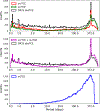
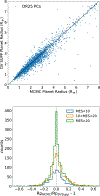


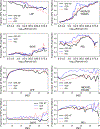






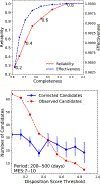
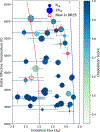

References
-
- Aigrain S, Llama J, Ceillier T, et al. 2015, MNRAS, 450, 3211
-
- Akeson RL, Chen X, Ciardi D, et al. 2013, PASP, 125, 989
-
- Ambikasaran S, Foreman-Mackey D, Greengard L, Hogg DW, & O’Neil M 2014, ArXiv e-prints, arXiv:1403.6015 - PubMed
-
- Barclay T, Rowe JF, Lissauer JJ, et al. 2013, Nature, 494, 452. - PubMed
-
- Barge P, Baglin A, Auvergne M, et al. 2008, A&A, 482, L17
Grants and funding
LinkOut - more resources
Full Text Sources
Miscellaneous
